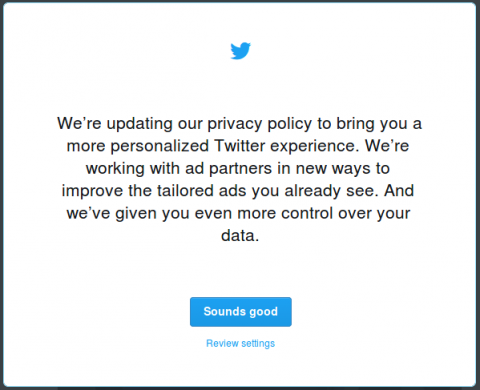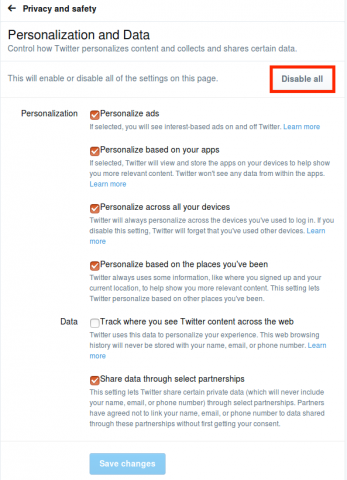Since Wednesday night, Twitter users have been greeted by a pop-up notice about Twitter’s new privacy policy, which will come into effect June 18:

Contrary to the inviting “Sounds good” button to accept the new policy and get to tweeting, the changes Twitter has made around user tracking and data personalization do not sound good for user privacy. For example, the company will now record and store non-EU users’ off-Twitter web browsing history for up to 30 days, up from 10 days in the previous policy.
Worst of all, the “control over your data” promised by the pop-up is on an opt-out basis, giving users choices only after Twitter has set their privacy settings to invasive defaults.
Instead, concerned users have to click “Review settings” to opt out of Twitter’s new mechanisms for user tracking. That will bring you to the “Personalization and Data” section of your settings. Here, you can pick and choose the personalization, data collection, and data sharing you will allow—or, click “Disable all” in the top-right corner to opt out entirely.

If you already clicked through the privacy policy pop-up, you can still go into your settings to make these changes. After navigating to your settings, choose “Privacy and safety” on the left, and then click “Edit” next to “Personalization and data.”


While you’re at it, this is also a good opportunity to review, edit, and/or remove the data Twitter has collected on you in the past by going to the “Your Twitter data” section of your settings.
Twitter has stated that these granular settings are intended to replace Twitter’s reliance on Do Not Track. However, replacing a standard cross-platform choice with new, complex options buried in the settings is not a fair trade. Although “more granular” privacy settings sound like an improvement, they lose their meaning when they are set to privacy-invasive selections by default. Adding new tracking options that users are opted into by default suggests that Twitter cares more about collecting data than respecting users’ choice.













